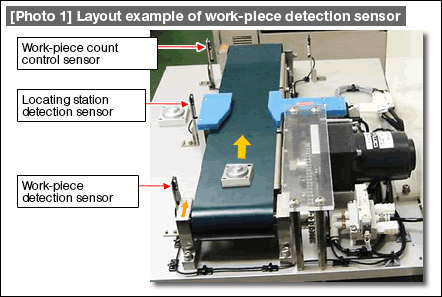#092 Motion Mechanism Design - 9 : Positioning Pusher Materials
Positioning pushers are needed with transfer conveyors in order to align and position work-pieces. Especially when the following process utilizes any automation, they are required.
- Out-feeding of work-pieces by Pick & Place units.
- Automated work-piece inspection with image processing systems.
- Processes requiring accurate work-piece positions such as automated soldering stations and resin dispensers.

(1) Focus points of positioning pusher material selections
The mechanism example uses an air cylinder (Pico-Table MPPT16-20-RS) to push and align the position of work-pieces on the conveyor.
- Lightweight ---- In order to lighten the load on the actuator
- Not to inflict scratches or dents on work-pieces.
- Wear resistant properties
(2) Positioning pusher material selections and characteristics
The materials used for the mechanism can be largely classified into the following.
- Metals ---- Ferrous metals, Aluminum, Copper
- Non-metal ---- Plastics, Ceramics
From the selection focus points of (1) above, the plastics are chosen as a candidate, especially with the criteria (1) - 3 engineered plastics are suitable.
When using plastics as parts of mechanisms, the mechanical strengths (tensile and compressive strengths, hardness, toughness) are lower than that of the general ferrous materials used, and the plastic wall thickness must be designed larger.
- Positioning technology
- Designing and processing
- Sensor Technology
- Automation elements technology
- Clean room technology
- Design hints
- Design tips
- Designing and Machining
- Drive mechanism design
- Hints on designing
- Linear Motion Components
- Locating Technology
- Manufacturing technology
- Motion mechanism design
- Pneumatic Drives
- Production Technology
- Technology Outlook
- General description
- Low-cost automation and materials
- Transfer LCA
- #333 Know-how on automation: Pressurized heating technology - 5: Multilayer pressurized heating process technique
- #332 Know-how on automation: Pressurized heating technology - 4: Points to remember when designing mechanism of pneumatic pressurization method
- #331 Know-how on automation: Pressurized heating technology - 3: Pneumatic pressurization method and pressure profile
- #330 Know-how on automation: Pressurized heating technology - 2: Pressurization method and pressure profile
- #329 Know-how on automation: Pressurized heating technology



